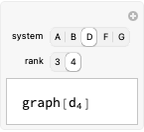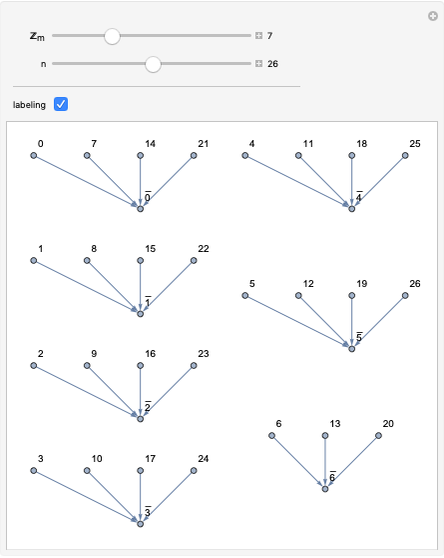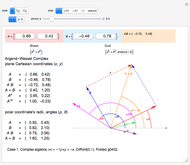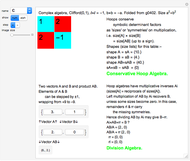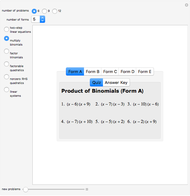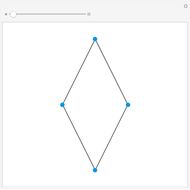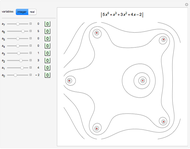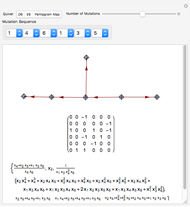Cluster Algebras

Requires a Wolfram Notebook System
Interact on desktop, mobile and cloud with the free Wolfram Player or other Wolfram Language products.
Cluster algebras are certain commutative rings introduced by Fomin and Zelevinsky. Their generators (called cluster variables) and algebraic relations are defined through an iterative process known as "seed mutations." The latter are defined in terms of a skew-symmetric matrix that can be represented as a quiver (a directed graph). To each node of the quiver, there is associated a transformation (called a mutation) that changes the original "seed," that is, the original skew matrix (or quiver) and the associated cluster variables  . This Demonstration shows several examples of how Mathematica can be used to generate a cluster algebra.
. This Demonstration shows several examples of how Mathematica can be used to generate a cluster algebra.
Contributed by: Bernhard Keller, Christian Korff, and Lauren Williams (January 2012)
(URF de Mathématiques, Paris 7; School of Mathematics and Statistics, University of Glasgow; and Department of Mathematics, UC Berkeley)
Open content licensed under CC BY-NC-SA
Snapshots
Details
This is a simple Demonstration of how Mathematica can be used to facilitate computations with cluster algebras. Cluster algebras were introduced by Fomin and Zelevinsky [2–4] and are a rapidly expanding subject in mathematics [5]. They have found applications in many different areas, including combinatorics, representation theory, number theory, and physics.
A cluster algebra can be generated from certain data (seeds), which consist of a skew-symmetric exchange matrix  representing a quiver
representing a quiver  (without loops or two-cycles) and cluster variables
(without loops or two-cycles) and cluster variables  . For simplicity, we treat here only the case without coefficients, but the source code can be manipulated to include the latter as well. This data,
. For simplicity, we treat here only the case without coefficients, but the source code can be manipulated to include the latter as well. This data,  , is subject to certain transformations called "mutations"; see [6] and [7] for an introduction.
, is subject to certain transformations called "mutations"; see [6] and [7] for an introduction.
A mutation around a vertex  of the quiver changes the exchange matrix
of the quiver changes the exchange matrix  according to the formula (matrix mutation)
according to the formula (matrix mutation)  and the variables
and the variables  according to the exchange relation
according to the exchange relation  and
and  for all
for all  .
.
Definition (Cluster algebras). Let  be a quiver without loops or two-cycles and with vertex set
be a quiver without loops or two-cycles and with vertex set  . Given the initial seed
. Given the initial seed  , where
, where  , define the clusters with respect to
, define the clusters with respect to  to be the sets
to be the sets  appearing in seeds
appearing in seeds  obtained from
obtained from  via iterated mutations, the cluster variables for
via iterated mutations, the cluster variables for  to be the elements of all clusters, and the cluster algebra associated with
to be the elements of all clusters, and the cluster algebra associated with  to be the
to be the  -subalgebra of the field
-subalgebra of the field  generated by all the cluster variables.
generated by all the cluster variables.
This Demonstration shows how the mutations change the initial seed for several examples. The important feature we would like to emphasize is that Mathematica allows one to combine graphical interactive displays of the quivers arising in cluster algebras with the needed symbolic computational power to manipulate the cluster variables. Fomin and Zelevinsky have shown that the cluster variables are always Laurent polynomials, that is, their denominators are always monomials. This Demonstration lets you verify this remarkable fact on simple examples.
The set of cluster variables in cluster algebras may be finite or infinite. According to a classification theorem by Fomin and Zelevinsky [8], the set of cluster-finite cluster algebras is parametrized by the finite root systems of semisimple Lie algebras; we have included here the examples  and
and  . The example related to the pentagram map [9] yields a cluster algebra of infinite type, since the mutation sequence 5-6-4-5-3 produces a matrix
. The example related to the pentagram map [9] yields a cluster algebra of infinite type, since the mutation sequence 5-6-4-5-3 produces a matrix  with
with  ; compare with [8].
; compare with [8].
References
[1] B. Keller. "Quiver Mutation in Java." (Jun 25, 2006) math.jussieu.fr/~keller/quivermutation/.
[2] S. Fomin and A. Zelevinsky, "Cluster Algebras I: Foundations," Journal of the American Mathematical Society, 15(2), 2002 pp. 497–529. doi:10.1090/S0894-0347-01-00385-X.
[3] S. Fomin and A. Zelevinsky, "Cluster Algebras IV: Coefficients," Compositio Mathematica, 143(1), 2007 pp. 112–164. doi:10.1112/S0010437X06002521.
[4] A. Berenstein, S. Fomin, and A. Zelevinsky, "Cluster Algebras III: Upper Bounds and Double Bruhat Cells," Duke Mathematical Journal, 126(1), 2005 pp. 1–52. doi:10.1215/S0012-7094-04-12611-9.
[5] S. Fomin. "Cluster Algebras Portal." (Jan 5, 2012) www.math.lsa.umich.edu/~fomin/cluster.html.
[6] B. Keller. "Cluster Algebras and Cluster Categories." (Apr 20, 2011) math.jussieu.fr/~keller/publ/KellerClustersBIMS.pdf.
[7] A. Zelevinsky, "What Is… a Cluster Algebra?", AMS Notices, 54(11), 2007 pp. 1494–1495. www.ams.org/notices/200711/tx071101494p.pdf.
[8] S. Fomin and A. Zelevinsky, "Cluster Algebras II: Finite Type Classification," Inventiones Mathematicae, 154(1), 2003 pp. 63–121. doi:10.1007/s00222-003-0302-y.
[9] M. Glick, "The Pentagram Map and Y-Patterns," Advances in Mathematics, forthcoming. arxiv.org/abs/1005.0598.
Permanent Citation








